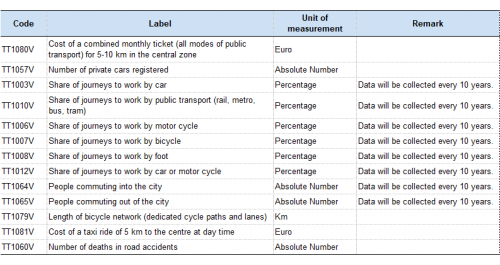City statistics – transport and travel patterns
Planned article update: October 2024
Highlights
This chapter of the City statistics manual provides the definitions that should be used for compiling data at city and functional urban area level in the domain of transport and travel patterns. In order to ensure comparability across countries, the recommended concepts and definitions are in line with those used for transport data compilation at the upper geographical level. Concepts and definitions regarding discontinued variables are not included in the chapter. The chapter also contains links to methodology, publications and external information.
Full article
Transport and travel patterns in cities
Variables:
Private passenger car registered (TT1057V): Passenger car registered by a natural person.
Car registrations: Total number of private passenger cars registered (by natural persons, not business, enterprises, so no taxis or hire cars registered by enterprises) to addresses within boundary on the 1st of January of the reference year. This is the total stock of cars, not just new registrations. Cars registered but no longer in use should be excluded. If the figure includes these cars, it should be stated in the footnote.
Passenger car: the definition of the 'passenger car' should follow that of the Eurostat 'glossary for transport statistics' but exclude cars registered by enterprises. In this context, a passenger car is defined as follows: Road motor vehicle, other than a moped or a motor cycle, intended for the carriage of passengers and designed to seat no more than nine persons – including the driver. The term 'passenger car' covers micro-cars (needing no permit to be driven), taxis and hired passenger cars, provided that they have fewer than ten seats. This category may also include pick-ups.
Journey to work refers to the usual trip (from the place of residency to the work place, including change of transport mode) of the persons employed within the boundary regardless the place of residency (commuters plus persons employed that live within the boundary).
People commuting into the city area (TT1064V): Residents of areas outside the city, whose employment location or client premises are within the city area. Students shall not be included if they are not commuting to work.
People commuting out of the city area (TT1065V): Residents of the city area, whose employment location or client premises are outside the city area. Students shall not be included if they are not commuting to work.
Share of the journeys to work by transport mode. The main mode must be reported so that all shares of transport mode add up to 100 %. TT1012V is an exception.
Public transport is the network of buses, trains, trams, etc. that run according to a planned time schedule and that anyone can use. The provider of the above-mentioned services may be either the municipal authority or privately owned enterprises.
Length of bicycle network (TT1079V) includes both dedicated cycle tracks and cycle lanes. Cycle lanes are part of a carriageway designated for cycles and distinguished from the rest of the carriageway by longitudinal road markings. Cycle tracks are independent roads or part of a road designated for cycles and sign-posted as such. A cycle track is separated from other roads or other parts of the same road by structural means. Mopeds may also be allowed to use cycle lanes or tracks.
Cost of a taxi ride of 5 km to the centre at day time (TT1081V): In most cities there are several taxi service providers and the fee can also depend on the waiting time (due to traffic jams). This figure should be estimated using central tendencies (for example: mean).
Cost of a combined monthly ticket (all modes of public transport) for 5-10 km in the central zone (TT1080V): In case of price change, the weighted-average has to be provided. The countries in which the cities have only one mode of transport should provide the real price for this service - explaining that in the metadata file. If a city has any public transport that is free of charge, the value provided for this should be 0. If a city does not have any public transport, the NSI should not provide any record for this variable as it is not applicable.
Motorcycle: Two-, three- or four-wheeled road motor vehicle not exceeding 400 kg (900 lb) of unloaded weight. All such vehicles with a cylinder capacity of 50 cc or over are included, as are those under 50 cc which do not meet the definition of moped.
Deaths in road accidents (TT1060V): People who were killed outright or who died within 30 days as a result of the accident. If the latter case happens in the new reference year, this number has to be counted in the previous one. All Member States should follow the international standard of 30 days established by the ECMT (European Conference of Ministers of Transport, an OECD body). Please note that, in order to ensure the geographical comparability, the preferred data source is the Police data complemented by the Hospital data.
Direct access to
Database
- City statistics (urb), see:
- Cities and greater cities (urb_cgc)
- Functional urban areas (urb_luz)
- Perception survey results (urb_percep)
Dedicated section
Publications
Visualisations
External links
This article forms part of Eurostat’s City statistics manual.

